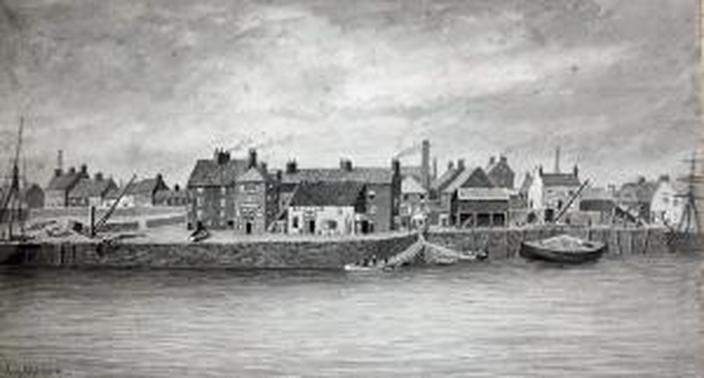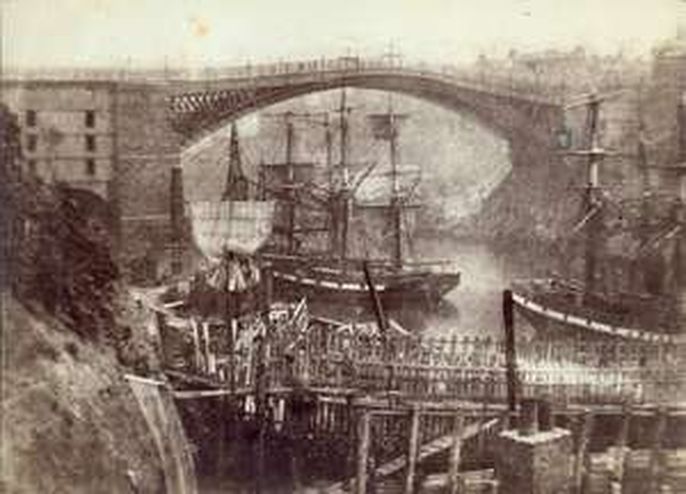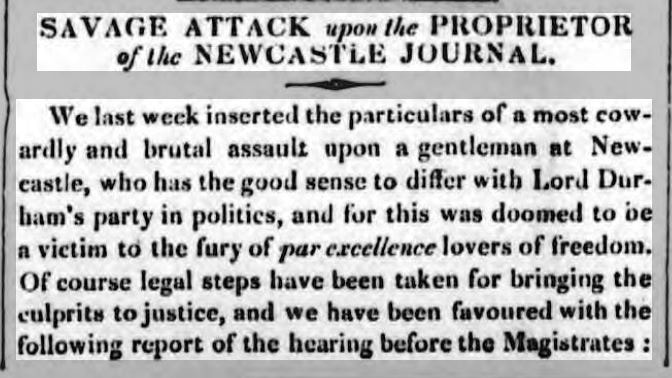|
Last month when writing of the Newcastle Hostmen, who also had a strangle hold on coals shipped from Sunderland until the mid 18th century, my mind was drawn back to my own family and their lives on the waters of Wearside. I touched on their story in a previous post ‘My DNA and the Ancestor that Dropped By’ and the murderous John Greig of Monkwearmouth Shore who danced the hangman’s jig from the Durham gibbet back in 1816 for fatally shooting a woman named Elizabeth Stonehouse. At the time of his death he left a widow Mary nee Bulmer and six children Grace b. 1808, Eleanor b. 1809, Jane & Mary b. 1813, William b. 1814 and Frances born born just two months before her fathers demise 1816. At the time of writing the original post a few rudimentary facts had been established in that Mary and her family had remained settled in the area, but little beyond. Interested to know more about how Mary and her children fared after what must have been a traumatic and potentially stigmatising event I have found the time to do a bit more digging. In addition, stepping back a generation into the family of Mary Bulmer, John Greig’s wife, has uncovered a few more interesting facts. Spurred on by DNA matches to descendants of John and Mary Greig's daughter Frances, (43cMs) and two of Mary’s siblings, Frances Bulmer(17.5cMs) & (18cMs) & Richard Bulmer(12cMs) it was also time to find out more about the Bulmer family and their various family connections. Mary was born in 12 August 1786 and baptised at St Peters Monkwearmouth on 29 Jan 1792 she was the eldest daughter and first child of eight children born to Richard Bulmer (a tailor) & Eleanor Johnson of Monkwearmouth Shore. Brothers William, Robert, and Richard are all described as ‘shipwrights’. This is not unsurprising as between the years 1846 – 1854 a third of all ships built in the UK were from Wearside, with 76 shipbuilding yards gracing the shores of the River Wear in 1840. ‘By the time of the 1851 census Sunderland Borough encompassed the whole of Sunderland, Monkwearmouth and Bishopwearmouth and was home to 63,897 people. Of the trades and professions represented in the town, seamen were the biggest group with 3,060 sailors resident in the town. Shipwrights (shipbuilders) were the next biggest group with 2,025 employed in this trade.'[1] Mary’s brother George Johnson Bulmer is described as a mariner. Mary’s sister Jane married William Embleton, formerly a farmer at Boldon, but latterly a Clerk living in Crow Tree Road, Bishopwearmouth. Sister Frances married a hairdresser by the name of John Collin by whom she had a veritable tribe of at least 10 children. Sister Eleanor did not marry and indeed she is the key to establishing the various family relationships and a bit of background to the family’s social history. Eleanor died in 1852 at her home in Derwent Street, Bishopwearmouth and was the only sibling to have left a detailed will in the pre 1858 period. The first family member to be mentioned in the will is her niece Grace Dixon nee Greig (widow, daughter of her sister Mary) to whom she bequeaths the freehold interest of a house on the ‘east side of Walton’s Lane otherwise Birds Lane in Sunderland’. She next leaves to her great niece Jane Eleanor Ranson (granddaughter of her sister Jane Embleton) ‘all the remainder of my silver plate together with my work box and writing desk’ having left her ‘silver cup’ to John Douglas an unmarried ships broker of Sunderland. We are clearly dealing with a woman who is of some means and apparently literate – why else would she possess a writing desk? She then mentions her three surviving brothers, William, Richard and George Johnson Bulmer to whom she leaves the sum of £19 19 shillings each. Next to be mentioned is her sister Mary (widow of John Greig) who is described as Mary Elliott. From this it appears that Mary remarried and there is a possible candidate in John Elliott a shipwright who married a Mary Greig in Monkwearmouth in 1821. As Mary would have been 35 at the time and very much capable of having further children, this should be born in mind in future research. Mary was clearly alive at the time Eleanor wrote her will but no Mary Elliott has been identified in either the 1841 or 51 census. A Mary Elliott died in Society Lane, Monkwearmouth Shore in 1859 aged 73 and although not proven, this is believed to be her. (It most certainly is not Mary Greig who died 1860 in Sunderland as she was the infant daughter of unknown Greig with a mothers maiden name of Cooke. The Mary Greig who died in 1864 is at least approximately the right age at 78, but as she died in Dock Street she is believed to be the wife of Robert Greig, a baker there born in Perthshire, a potential (but unproven) sister in law to the hanged man). Eleanor made further bequests of £50 each to nieces Elizabeth Carter, (daughter of her sister Jane), Eleanor Brown, (possibly the daughter of her sister Mary as Eleanor daughter of sister Frances was married to a mariner by the name of King, and Eleanor daughter of brother Richard was as yet unmarried) Mary Ann Ranson (daughter of sister Jane) and Mary Collin (daughter of her sister Frances). Lastly, Eleanor left £5 each to Hannah Scouler, widow of Deptford Sunderland and her daughter Grace Blackett of Deptford, Kent for whom no familial connection has yet been firmly established. However, from her marriage to William Scouler in 1815 it becomes apparent that Hannah’s maiden name was Greig, and a possible baptism in 1789 would indicate she was a sister to John, of the stray Mackem bullet. The strangest bequest, however, was the first. Eleanor gifted the freehold of her house on the ‘north side of Derwent Street’ to Emma, Elizabeth, and Thomas Paterson children of Emma Paterson (deceased) late of Alnwick, the sister of the late John Coull Carr’. What on earth was the connection here to warrant leaving the freehold of her house to three apparently unrelated children – and just who was John Coull Carr? My interest was further piqued by a court document from 1836 that stated ‘Misdemeanour sending a challenge to fight a duel’ with pistols, for which offence he and a Mr Alexander Kirkaldy were sentenced to 3 months imprisonment. It transpired the cause of the challenge amounted to little more than a slanging match between between the two ‘gentlemen’. In January of that year Mr Carr had been elected a Councillor for Bridge Ward Sunderland, he was a timber merchant in his own right and also acted as a coal agent for the Earl of Durham. Durham was none other than John Lambton, nicknamed ‘Radical Jack’ who in his capacity as Lord Privy Seal helped draft the Reform Bill of 1832. Carr’s support for Durham had previously got him in hot water when he accused the Newcastle Journal of slander in 1833. The case which became known as the ‘Durham Libels’ was caused by a difference in political opinion. Further rummaging through wills turned up the testament of the aforesaid ‘gentleman’ who having been declared bankrupt in 1842 died in 1847. His will was written in February 1845 in which he bequeathed his entire ‘real and personal estate, household furniture, plate, linen outstanding debts money securities and all other personal estate and effects whatsoever and wheresoever’ to ‘Eleanor Bulmer spinster of Bishopwearmouth’ whom he also appointed his sole executor. He must have experienced a remarkable turn around in fortune as he was in possession of an estate worth £800 at the time of his death. Was this how Eleanor Bulmer came into her property? The answer is inconclusive as Mr Carr cannot be traced in association with either of the properties mentioned in her Will. In the 1851 census Eleanor is described as an ‘Annuitant’ living at No 9 Derwent Street, next door to her niece the widowed Grace Dixon, who is running a lodging house with children Isabel and Joseph. To date Eleanor Bulmer remains a bit of an enigma but she does appear to have been an intelligent and generous woman from her bequests to apparently unrelated persons. What exactly was her relationship with the infamous Mr Carr? If like me you have few Ancestry DNA matches at 4th cousin or closer, tracing potential matches as far back as 4th and 5th great grandparents can be a tricky business. Firstly there is no guarantee that we will have inherited any DNA from ancestors beyond our 3rd great grandparents and secondly, Ancestry does not show mutual matches beyond 4th cousin. Here I would recommend transferring your raw DNA into other databases such as My Heritage, Family Tree DNA, and GEDmatch, all of which can be done for free. Another obstacle is that many folks simply don’t know their ancestry that far back, meaning the potential most recent common ancestor (MRCA) is absent from their tree. Worse still are trees full of incorrect information thus obscuring the family you potentially match with – an all too common problem! To help overcome this I would recommend you figure out the collateral lines of ancestors and add them into your own tree – if someone speculative is added, attach a note to the individual in question, to remind you how and why you think they might be related as an aide memoire to future research. Another approach is to work the ancestral lines of DNA matches yourself, a laborious process perhaps, but worth the effort, particularly if you are suspicious where the match occurs. As a note to end this month's blog with all the connections to Wearside I can't help but wonder if another enigmatic filly 'The Mackem Bullet' by Society Rock, trained by Brian Ellison is worth a speculative flutter for next year's 1,000 Guineas Some Useful and Interesting SourcesFor those interested in the industrial history of Sunderland, David Simpson’s of England’s North East has an analysis of the 1851 census and findings make interesting reading, as do many of his other posts on his website http://englandsnortheast.co.uk/sunderland-industries/
Street Maps of Sunderland in 1860 http://www.durham-images.org/public/ms/spin.html Sunderland: A History of the Town, Port, Trade and Commerce https://archive.org/details/sunderlandahist00pottgoog Personal recollections written by Taylor Potts of Sunderland in 1892 Looking for Durham Ancestors? I thoroughly recommend using Durham Records Online as their records contain full transcripts which often yield far more information than other online indexes.
1 Comment
25/8/2018 02:03:59 pm
Super post and particularly interesting as I had just bee reading about Monkwearmouth and an ancestor, George Caithness, who surprisingly (to me) was a Master Mariner 'of Monkwearmouth Shore, Sunderland'. George had tried to make a living ashore as a publican, given the vicissitudes of life as a merchant captain, but things did not go well and he got into financial difficulties being consigned to Durham gaol for debt.
Reply
Leave a Reply. |
AuthorSusie Douglas Archives
August 2022
Categories |
Copyright © 2013 Borders Ancestry
Borders Ancestry is registered with the Information Commissioner's Office No ZA226102 https://ico.org.uk. Read our Privacy Policy






